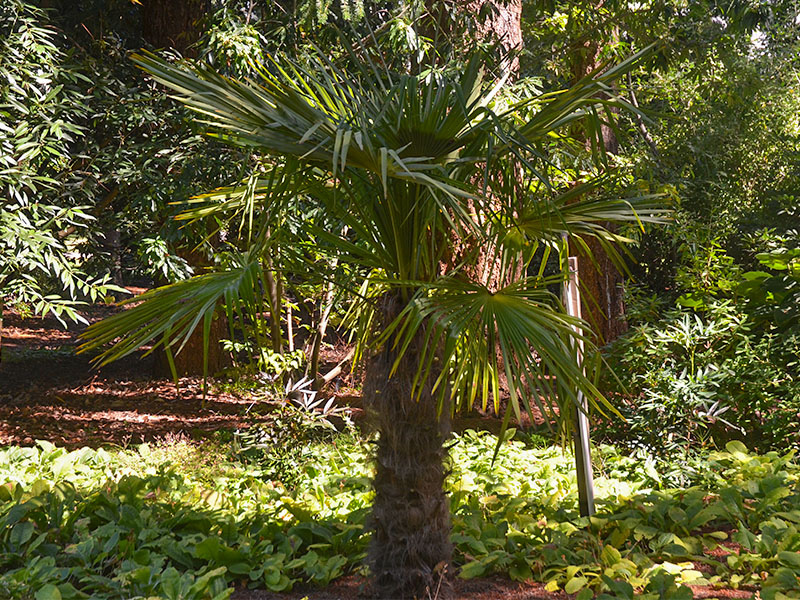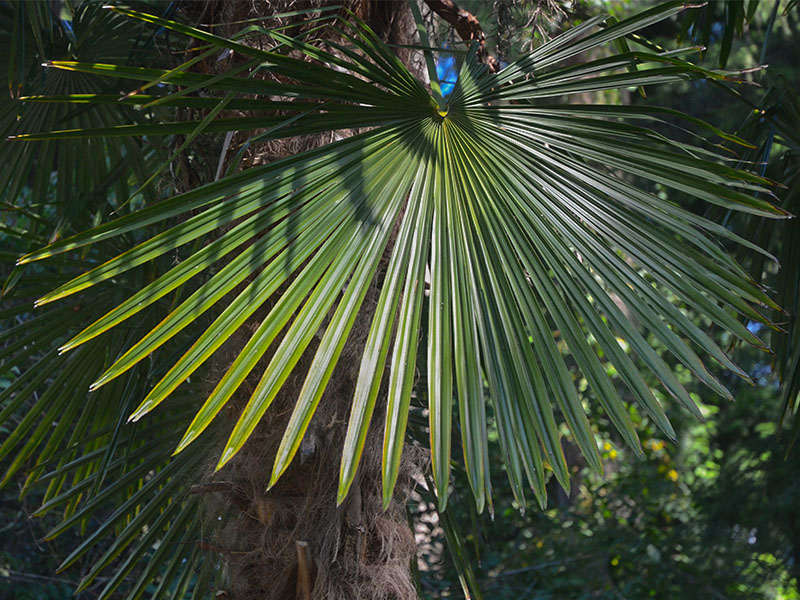
Tropicals, Woody > Trachycarpus > Trachycarpus fortunei > Trachycarpus fortunei
Trachycarpus fortunei
Windmill Palm, Chusan palm
Origin: This palm has a range from the Himalayas, Bhutan, India, Myanmar, Nepal, and through the mountains of Southern and Central China. First introduced by Scottish horticulturist Robert Fortune in 1844.
Mike's
Opinion


"
This palm is one of the hardiest in the world. For those who want the exotic feel in the garden or want something that would be used in a Victorian garden, Trachycarpus fortunei or wind mill palm will fit the bill. Trachycarpus fortunei is a plant that will handle most conditions once established. The windmill palm is hardy to zone USDA 7 but with a bit of protection from mulch it can be grown in cooler zone 6.
Michael Pascoe, NDP., ODH., CLT., MSc. (Plant Conservation)
"
| Family |
| Arecaceae |
| Genus |
| Trachycarpus |
| Species |
| fortunei |
| Category |
| Tropicals, Woody |
| Type |
| Tree (evergreen) |
| USDA Hardiness Zone |
| 7a - 8a |
| Canadian Hardiness Zone |
| 7b |
| RHS Hardiness Zone |
| H5 |
| Temperature (°C) |
| -15 to -9 |
| Temperature (°F) |
| 5 - 15 |
| Height |
| 3 - 12 m |
| Spread |
| 2 - 3 m |
Photographs
Description and Growing Information
Flowering Period
| General Description |
| This is a medium to large tree based on climate. The palm has a single leading trunk that is covered with a thick burlap-like coat . The fronds are palmate. |
| Landscape |
| Used in Japanese gardens as well as exotic gardens as an accent or specimen plant. Due to its popularity it has become naturalized in some parts of the world. |
| Cultivation |
| Trachycarpus fortunei is a very sturdy plant that can handle a wide range of conditions but in general the plant likes full sun to partial shade with moist soil. The soil can range from acidic to alkaline that is well-drainingl. |
| Shape |
| This tree when young is short with a cluster of fronds coming out of the top. At maturity this palm has an upright growing pattern. The plant also has a parallel mound of fronds at maturity. |
| Growth |
| Medium |
| ID Characteristic |
| Fibrous covered trunk holding a tuff of green fan-shaped leaves. |
| Pests |
| Pests include palm aphids, spider-mites, scale, lethal yellowing disease and leaf spots. |
| Habitat |
| Grows in the mountainous regions of South-East Asia in subtropical and warm temperate forests at 100 - 2400 m above sea level. |
| Bark/Stem Description |
| This palm has a thick coat of burlap-like fiber which grows from the trunk of the tree. The trunk may also have dead fronds attached from the year before, unless removed or they have fallen off. |
| Leaf Description |
| Trachycarpus fortunei produces leafs with a spread of 1.8 - 3 m. The width of the leaf is on average between 46 - 91 cm. The tree has an alternating leaf arrangement with a simple palmate leaf structure. |
| Flower Description |
| Trachycarpus fortunei is dioecious and flowers in early summer. They are densely packed in the inflorescence and can be yellow, cream, white or grey. |
| Fruit Description |
| It is blue in colour, 1.27 - 2.54 cm long with a waxy coating. |
| Colour Description |
| This tree has medium texture throughout the year. |
| Texture Description |
| Leaves are a rich shade of green. The leaves will stay the same colour year round unless the plant experience leaf desiccation from freezing which will change the leaf to a dull green. Colour of the trunk will stay the same all year round. |
| Notable Specimens |
| Trewidden Garden, Cornwall, United Kingdom. VanDusen Botanical Garden, Vancouver, British Columbia, Canada. Trebah Garden Trust, Mawnan Smith, Falmouth, Cornwall, United Kingdom. Cotehele House National Trust, St Dominick, Cornwall, United Kingdom. Glendurgan Garden, Mawnan Smith, Falmouth, Cornwall, United Kingdom. |
| Propagation |
| The most common method of propagating Trachycarpus fortunei is by seed. The seeds need to be above 25°C in order to germinate. The seed will need to be planted in a well-draining mix in a seed tray and will take 4 - 6 months to germinate. |
| Ethnobotanical Uses (Disclaimer) |
| The uses range from making wax from the fruit, fibers from leafs, animal feed from the seeds, alcohol and pillars made from the trunks for use in houses. |
References
PLANTS OF CHINA A COMPANION TO FLORA OF CHINA.H.De-Yuan.S.Blackmore. Trachycarpus fortunei .Retrieved march 20th,2016
Palms Of Southern Asia.Andrew Henderson. Trachycarpus fortunei .Retrieved march 20th,2016
The New York Botanical Garden.



